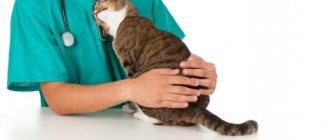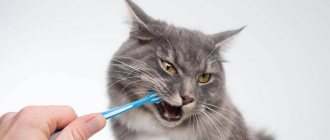5771Pavel
“Nepnritis” translated from Greek, nephritis is a severe, infectious-allergic disease that directly affects the kidneys. It can occur acutely, subacutely and chronically, and the area of localization is diffuse and focal. Depending on the stage of the disease, the symptoms and treatment of nephritis in cats vary. The kidneys act as a kind of filter, taking on all the negative consequences of infectious diseases, inflammatory processes and allergic reactions. It is important to understand that this is a dangerous disease that requires the intervention of a qualified specialist.
What to do if your cat has nephritis?
“Nepnritis” translated from Greek, nephritis is a severe, infectious-allergic disease that directly affects the kidneys. It can occur acutely, subacutely and chronically, and the area of localization is diffuse and focal. Depending on the stage of the disease, the symptoms and treatment of nephritis in cats vary. The kidneys act as a kind of filter, taking on all the negative consequences of infectious diseases, inflammatory processes and allergic reactions. It is important to understand that this is a dangerous disease that requires the intervention of a qualified specialist.
What causes it to appear?
In many cases, acute nephritis in cats appears due to the action of pathological microflora. This happens when the cat already has some kind of infection (canine distemper, for example). Since the kidneys act as a natural filter through which a huge volume of blood passes, the causative agent of the disease inevitably ends up in them. Of course, it all ends in an inflammatory reaction. The same applies to viral and parasitic diseases. Leptospirosis is extremely dangerous in this regard, as it inevitably leads to kidney damage. In some cases, medications can cause kidney nephritis in cats. This happens especially often among owners who like to “treat” their pet from all real and imaginary diseases, indiscriminately stuffing them with potent drugs.
Important! Fans of “self-medication” should be warned that their actions may significantly complicate diagnosis. This is extremely dangerous for the animal itself!
Types of jade
Inflammation of the kidneys is distinguished by the severity of the process. It can be manifest or chronic. Depending on the tissue damage, the following types of disease are distinguished:
- Glomerulonephritis. The kidney glomeruli are destroyed and gradually die.
- Pyelonephritis is a purulent inflammation of the renal pelvis.
- Interstitial. In this case, the kidney tubules become inflamed and urine filtration is impaired. It is rare in cats.
Causes
There are many causes of nephritis, but the most common signs of the disease in cats are:
- Incorrect use of medications.
- Poisoning with household chemicals.
- Poor nutrition or poisoning from poor quality food.
- Damage to the body by helminthic infestation.
- Hypothermia, injuries, etc.
Note. Most often among animals, cats are susceptible to nephritis; for example, in dogs this disease appears 3 times less often.
Causes of kidney diseases:
Often it is not possible to accurately determine the causes of the disease. The most typical are: age, genetic predisposition or congenital anomaly, ecology, infectious and systemic diseases (for example, diabetes), poisoning, trauma, unbalanced nutrition.
All animals over 7 years of age are at risk. They should be examined annually by a veterinarian, have blood tests, urine tests, ultrasounds and blood pressure checked.
Diagnostics
To diagnose kidney pathologies, veterinarians resort to a number of studies. First, blood and urine tests are done to assess the concentration of substances that are normally filtered by healthy kidneys.
In addition, the doctor may prescribe:
- Ultrasound of the abdominal cavity;
- fluoroscopic examination;
- urine culture;
- biopsy.
Important!
Kidney pathologies are serious diseases that require early diagnosis - do not delay a visit to the veterinarian!
Symptoms
Experts identify several types of disease; glomerulonephritis, interstitial, pyelonephritis and genetic predisposition. Please note that the symptoms of nephritis in a cat and a cat are identical. Depending on the severity of the disease, there are many pronounced symptoms. Let's look at which ones :
- General depression, sick appearance and decreased appetite in the cat.
- When you press in the kidney area with nephritis, pain appears.
- During the disease, the mucous membranes are affected, and swelling of the eyes and ears appears at their base.
- The urine becomes very dark and cloudy, and may contain pus and blood.
- A characteristic specific smell appears, the urge to urinate with nephritis increases, but the amount of urine decreases. In some cases, a cat may make plaintive sounds while urinating.
- Due to possible damage to the body by intoxication during nephritis, vomiting appears and thirst increases.
- Body temperature and blood pressure increase.
- The appearance of dry mouth, as a result of which cats often lick their lips.
- Perhaps the appearance of an ammonia odor from the animal's mouth.
- Some cats and kittens experience decreased skin elasticity and foul-smelling diarrhea.
- In rare cases, shortness of breath may occur with nephritis.
Self-medication in most cases aggravates the course of the disease, especially with infectious nephritis in a cat, and can lead to irreversible consequences. As the disease worsens, kidney failure and inflammation of the bladder may occur. Diagnosis of the disease is carried out using laboratory tests of the animal’s urine, ultrasound of the kidneys and a general examination of the animal by a veterinarian. In some cases, a kidney biopsy may be ordered.
Symptoms: how does the disease manifest itself?
Nephritis in a cat has the following symptoms:
As a result of the illness, the pet develops characteristic shortness of breath.
- hyperthermia;
- frequent and scanty urine mixed with blood or cloudy sediment;
- lethargy, loss of interest in life;
- lack of appetite;
- increased thirst;
- frequent shallow breathing or shortness of breath;
- swelling of the paws, eyelids, ears;
- pain during urination;
- cyanosis or yellowness of mucous membranes;
- vomit.
Therapeutic measures
Let us immediately note that self-treatment is strictly contraindicated, especially for infectious nephritis. It is necessary to conduct research and take tests. An ultrasound examination of the affected kidneys will not hurt. All this is done to determine the exact type of pathology. This determines how to treat a sick animal. It is simply impossible to do all these manipulations at home, so immediately take your pet to a veterinary clinic. However, there are some recommendations for owners, following which you can alleviate the animal’s condition. Firstly, diet. Dry food, as well as salty, smoked, and fried foods should be excluded from the cat's diet. This is what to feed a cat with nephritis.
If the animal has been treated with something, immediately inform the veterinarian, who will decide whether to continue therapy or stop using the drug. The cat needs to be given complete rest and provided with plenty of clean, cool water. If antibiotic therapy is carried out (and this is probably the case!), then water will become especially important.
Treatment
In most cases, acute nephritis in cats is not so mild, and the pet may experience severe pain. Treatment methods are determined by the doctor after a complete examination of the animal, depending on the stage of the disease. Many of the manipulations cannot be performed at home, so it is important that they are carried out by a specialist. The main therapeutic measures include :
- During the treatment of nephritis, it is necessary to place the cat in a warm place and ensure rest. In acute cases of the disease, a 12-hour fast is prescribed.
- Diet. Doctors recommend low protein foods. The consumption of spicy, salty and dairy products is excluded.
- Corticosteroids (used for acute disease and); Prednisolone, Dexamethasone.
- Treatment with broad spectrum antibiotics; usually from the group of cephalosporins.
- Diuretics to prevent swelling and remove excess fluid during nephritis; Temisal, Furosemide, decoction of bearberry leaves, tincture of parsley leaves, Magnesium sulfate, etc.
- Iron supplements (if symptoms of anemia appear); Hemobalance, Ursoferran.
- Medicines to treat diarrhea (if any); Verakol, Hilak-Forte, Linex, Vetom 1.1.
- Laxatives (in case of constipation); Duphalac, Lactusan, vaseline oil.
- If symptoms of dehydration appear, a nutritional cocktail is prescribed; Ringer-Locke solution with glucose.
- The use of vitamin B during nephritis speeds up the healing process.
- Drugs to relieve intoxication; Enterosgel, Liarsin.
- Antiemetics; Metoclopramide, Ondansetron.
- Sedatives (in case of symptoms of heart failure); Riboxin, Cocarboxylase.
Treatment: which methods are effective?
Use of pharmaceuticals
All medications and dosage are prescribed by a doctor; self-medication leads to the death of the animal. Treatment of nephritis in cats includes a set of medications shown in the table:
| Pharmgroup | Medication |
| Antibiotics | "Amikacin" |
| "Erythromycin" | |
| "Gentamicin" | |
| "Amoxiclav" | |
| "Amoxicillin" | |
| "Vetrimoxin" | |
| Diuretics | "Furosemide" |
| "Veroshpiron" | |
| "Amiloride" | |
| "Torasemide" | |
| Potassium acetate | |
| Magnesium sulfate | |
| Vitamin complexes | "Aminosol" |
| "Fort Dodge Dufalight" | |
| "Gepavi-kel" | |
| "Tetravit" |
Medical nutrition
Among the abundance of medicinal foods, the owner can choose Purina Veterinary Diets and switch the pet to it.
If you have nephritis, you should exclude salty, smoked, fried, fatty foods from your cat’s diet, and reduce the amount of protein foods. The animal should eat fractionally, in small portions. The menu should include low-fat cottage cheese and kefir, cereal porridge, boiled vegetables and lean broth. Among feeds, preference should be given to those produced for kidney diseases. These include:
- Purina Veterinary Diets;
- Hill's Prescription Diet;
- "Advance";
- Royal Canin;
- "Farmina."
Herbal treatment
The use of herbal infusions for nephritis in cats is mandatory, since herbal remedies accelerate the penetration of antibiotics into the renal structure.
The decoction should be given to the cat through a syringe without a needle, in small portions so that the animal can swallow without choking. Inflammation of the kidneys should be treated with herbs such as bearberry, lemongrass, knotweed, dandelion, immortelle, and flax seeds. You can prepare each herb separately or make a mixture by mixing them in equal proportions. Juniper berries are effective and can be added to food. Preparation:
After brewing bearberry, the owner can give the pet this drink several times a day. Take 5 g of any plant or mixture, pour 200 ml of boiling water.- Let it brew for 20-30 minutes, cool, filter.
- Dilute the resulting broth with boiled water.
- Drink 10-15 ml 3-4 times. per day.
Useful materials:
- Cloudy eye in a cat Common causes of cloudy eyes in a cat The most common causes of cloudy eyes are glaucoma, cataracts or keratitis.…
- Cutaneous horn General description of the disease Cutaneous horn on the forehead or face (ICD 10 code - L57.0) -...
- Itching and odorless discharge Main causesBefore considering the factors that provoke the appearance of discharge that has a sour odor, it is necessary to immediately note...
- A cat’s liver How to determine that there is a malfunction in the liver All harmful substances that enter the cat’s body with ...
Feeding cats with kidney disease
For all kidney diseases, a therapeutic diet is prescribed. Properly selected food can prolong a cat’s life and improve its quality. Only a doctor prescribes a diet for sick animals - experiments in such a serious matter can lead to a sad outcome.
Veterinarians usually recommend switching the animal to ready-made medicated food. It is difficult to create a menu from natural products that will meet the needs of a sick cat.
Recommended brands of food:
- Eukanuba Renal;
- Clan Vet RENAL;
- Hill's Prescription Diet K/D Feline Renal Health;
- Brid VDC Renal;
- Farmina Vet Life Renal;
- Royal Canin Renal RF23;
- Pro Plan Veterinary Diets Feline UR Urinary;
- Monge Grain Free Vetsolution Renal Feline;
- Purina Veterinary Diets N;
- Sanabelle Urinary.
Prevention
It is easier to prevent a disease than to eliminate its consequences. We suggest you familiarize yourself with the basic preventive measures that will help keep your pet healthy .
- Proper nutrition . It is necessary to provide cats and kittens only with high-quality food, preferably home-cooked. If you can’t cook yourself, you can feed him dry food of at least premium class. It should also be excluded from the diet; salted, smoked, fatty, fried.
- Physical exercise . A sedentary lifestyle in cats leads to the formation of excess fat cells and metabolic disorders. This can cause kidney disease, including nephritis. Therefore, the pet must be provided with a sufficient amount of physical activity. For example, playing with a ball or using special game “fishing rods”.
- Avoid hypothermia . To prevent kidney disease, you need to keep your cat warm and avoid drafts.
- Weight control . If your pet is overweight, then it is necessary to use a health-improving diet.
- Taking vitamins . Premium and superpremium cat food contains a sufficient amount of vitamin complexes and no additional vitamin intake is required. If the diet consists only of natural products, without the use of dry food, then it is necessary to add vitamins to the food.
- Drinking water . For proper kidney function, it is necessary to provide the animal with constant access to clean, drinking water. Cleanliness of the cat's litter box. It must be regularly treated with special disinfectants.
The prognosis for the acute course of the disease is in most cases unfavorable. Therefore, the sooner a cat gets to the doctor, the greater the chance of a quick cure for nephritis without complications. If, when symptoms are detected, it is not possible to hospitalize the animal yourself, keep the pet warm and limit access to food until the doctor arrives.
What to do first
If such a disease is detected, the pet, of course, may be prescribed medication. Both nephritis in cats, the symptoms of which were discussed above, and other diseases of the genitourinary system, with the correct selection of drugs and when used according to the regimen prescribed by the doctor, go away quite quickly.
A cat with such a pathology, of course, should first be shown to a veterinarian. In any case, after detecting symptoms, your pet should immediately be put on a starvation diet. Also, the animal must be kept warm.
A sick pet should be fed frequently. At the same time, the cat’s diet should definitely include foods that contain large amounts of potassium, calcium and carbohydrates and are low in table salt and protein. It would be a good idea to give a sick cat, for example:
- low-fat fermented milk products (kefir 1%);
- cereal and vegetable porridges;
- low-concentrated meat broths.
In case of acute nephritis in cats, fried, salted, smoked and baked foods should never be given to pets. Also, owners of such animals will have to refuse to purchase industrial feed. In case of an acute form of the cat, you can try to help by replacing the water in its drinking bowl with a decoction prepared from diuretic medicinal herbs.
Nephritis in cats
Nephritis
– from Latin nephos
-kidney and
itis
-inflammation - a term that combines various inflammatory diseases of the kidneys. In cats there are:
- Glomerulonephritis
- Pyelonephritis
- Interstitial nephritis
Nephritis in cats can occur:
Nephritis occurs both without changes in kidney function and with the development of acute and chronic renal failure.
Pyelonephritis
- inflammation involving all structures of the kidney, caused by various bacteria (most often E.coli
,
Proteus
,
Staphylococcus
). Often develops against the background of inflammation of the uterus (metritis), urocystitis (inflammation of the bladder, when the patient has not received the necessary treatment for the latter or has undergone an insufficient course for cure), predisposes to the spread of infection - cessation of urine flow when the urinary tract is blocked due to urolithiasis, as well as hematogenous by - i.e. with the bloodstream, when the source may be any source of inflammation in the body or systemic viral/bacterial infections.
Glomerulonephritis
- an autoimmune disease that affects only certain structures of the kidney - glomeruli (glomeruli).
Interstitial nephritis
- inflammation of the kidney tissue of a non-infectious nature with damage to the interstitial tissue and renal tubules. One of the causes of the last stage of kidney loss in cats (nephrosclerosis). The disease is still poorly understood, and intravital diagnosis is difficult.
Often the symptoms of nephritis in cats are nonspecific and similar to signs of other diseases:
- Decreased activity
- Decreased appetite
- Nausea
- Very rarely - shortness of breath
- Pain in the lumbar region - usually detected only during examination by a veterinarian
More characteristic of jade is:
- Increased, but not difficult and usually not painful urination
, much less often - scanty urination; - Increase fluid intake;
- Dry mouth
(in addition to the fact that the cat drinks a lot, it may lick itself frequently); - The urine may have an unpleasant odor;
- May change the color of urine, often becoming cloudy;
- Specific changes in urine analysis
(appearance of a large number of leukocytes, red blood cells, protein, renal epithelium, casts); - Increased body temperature
is relatively uncommon in cats with acute nephritis; - Very rarely in cats there is swelling of the limbs and other parts of the body.
- Ultrasound of the kidneys and bladder;
- Analysis of urine;
- Clinical and biochemical blood tests;
- Determination of urine protein/creatinine ratio;
- In some cases, a kidney biopsy (taking a tiny piece of kidney tissue using a special needle) may be recommended to determine the exact diagnosis.
Causes and symptoms of the disease
There are many reasons for the development of inflammatory kidney damage in cats. Most often, such a violation occurs due to the influence of the following unfavorable factors:
- helminthic infestations;
- acute and chronic infectious diseases;
- poor nutrition;
- eating poor quality food;
- chemical poisoning;
- irrational use of drugs;
- injuries;
- burns;
- allergic reactions;
- severe dermatological diseases.
In addition, autoimmune processes occurring in the animal’s body can contribute to the appearance of inflammatory kidney damage. There is also the possibility of a hereditary predisposition to developing nephritis. Some cat breeds are more likely to suffer from inflammatory kidney disease than others.
The symptoms of nephritis depend on the degree of neglect of the pathological process. In some cases, cat owners fail to notice that the animal has a problem, because... the inflammatory process is short-term in nature and its manifestations decrease after the cause of the problem is eliminated. However, if the inflammation affects large areas of the kidneys and persists for a long time, the symptoms become extremely severe. Signs of this pathological condition include:
- loss of appetite;
- decreased mobility;
- oppression;
- swelling of the base of the ears, eyelids and mucous membranes;
- darkening of urine;
- gray-green impurities in the urine;
- vomit;
- strong thirst;
- increased blood pressure;
- increase in body temperature;
- drying of mucous membranes;
- unpleasant odor of urine;
- dyspnea.
In addition, inflammatory damage to the kidney tissue leads to severe pain in cats. Because of this, palpation of the abdomen, as well as the process of urination, can cause a feeling of anxiety in the animal. The cat may meow pitifully. If the organ is severely damaged, the pet stops going to the toilet.
Signs of disease development
Of course, all lovers of these pets should know what symptoms appear most often in cats with nephritis. Signs of this disease in acute form, in addition to problems with urination, are:
- decreased appetite and depressed state;
- pain when pressing in the kidney area;
- swelling of the eyelids, paws, base of the ears;
- jaundice.
In case of acute nephritis, a sick cat begins to go to the litter box very often. At the same time, the amount of urine she produces decreases.
Chronic nephritis in cats can be preliminarily diagnosed by the presence of symptoms such as:
- frequent “trips” to the tray with large amounts of urine;
- unpleasant ammonia odor from the animal’s mouth;
- apathy;
- vomiting and persistent diarrhea.
The body temperature of a cat with a chronic form of the disease remains normal. The urine of cats with kidney nephritis is usually cloudy and brown or reddish in color. While visiting the tray, sick animals may take unusual poses or make strange sounds.
With nephrosis in cats, among other things, immunity sharply decreases. And this, in turn, can lead to infection of the pet with fungi, viruses or bacteria. Quite often, with nephrosis, anemia is also diagnosed in a cat.
Acute and chronic nephritis in cats: symptoms and treatment
The kidneys play the role of a filter in our body. Kidney disease is very dangerous, but unfortunately very common in cats. In this article we will try to talk about such a disease as nephritis in cats , what its symptoms are and the necessary treatment, possible causes of its occurrence and preventive measures. All information is provided for informational purposes only.
. Never self-medicate, it is dangerous for your cat's health. If medications are used incorrectly, complications that can be fatal can occur.
Diagnosis and treatment
The cause of the pathological condition of the disease is determined by clinical examination. Anamnesis is informative. They examine the urine, prescribe a general analysis and blood biochemistry, and perform an ultrasound of the abdominal organs. With nephritis, pathological symptoms characteristic of anemia, cardiovascular and respiratory diseases, and hepatitis develop. Nephrosis is excluded.
The treatment strategy is developed taking into account the presence of concomitant diseases in the following areas:
- Dietary therapy: prescribe veterinary nutrition for cats with kidney disease. The components of the feed mixture are selected so that the amount of phosphorus and nitrogen is minimal. Since the ingredients cannot satisfy the cat’s need for amino acids, their synthetic analogues are used. The feed contains buffer mixtures that prevent the precipitation of uric salts.
- Detoxification is the administration of medications that convert toxic waste into safe compounds.
- Accelerated evacuation of bladder contents to remove toxic metabolites from the body.
- To treat pyelonephritis, antimicrobial agents are used that sanitize the urinary tract and renal pelvis.
- Glomerulonephritis is treated with anti-inflammatory hormonal immunosuppressants.
Acute nephritis is well treated and ends with recovery. However, there is a predisposition to kidney disease. Chronic nephritis is incurable. To prolong life while ensuring satisfactory well-being, dietary food is prescribed for cats with kidney disease. To prevent exacerbations, courses of prophylactic use of anti-inflammatory or antimicrobial drugs are prescribed.
Characteristic signs
The symptoms of leukemia are varied. The following signs raise suspicion:
- digestive disorders;
- inflammation of the gums;
- constant illness;
- disheveled fur, oppression;
- enlargement of local lymph nodes;
- anemia;
- eye lesions;
- salivation;
- abortions;
- infertility;
- tumors.
- paresis of the limbs.
Nephritis in cats: causes
- Causes of nephritis in cats include:
- exposure to pathological microflora. Nephritis affects the kidneys, which are the body's natural filter; a very large amount of blood passes through them. If the animal’s body is affected by any infection, the amount of pathological microflora that was produced during the course of the disease will in any case pass through the kidneys with the blood. Because of this, an inflammatory reaction occurs, which in turn leads to nephritis;
- illiterate use of medications. Some owners, in pursuit of the health of their pet, often flirt and begin to stuff the cat with a variety of medications or use them incorrectly. For example, if you want to protect your pet from fleas, they use medications that need to be applied to the withers. If you overdo the dose, it can lead to kidney disease;
- food poisoning - with poor nutrition and consumption of spoiled foods, it is easy to get poisoning of the body, which provokes nephritis;
- poisoning from household chemicals;
- the activity of internal parasites - many worms secrete a huge amount of toxins while in the cat’s body. Because these toxins enter the bloodstream, the kidneys filter them and take the hit;
- epidermal lesions. Diseases that affect the skin of an animal can cause nephritis. This is due to the presence of a huge number of blood vessels in the pet’s skin. During inflammation, all bad bodies enter the bloodstream, and subsequently pass through the kidneys and genitourinary system, and therefore can damage them. Skin diseases include any kind of dermatitis, burns, ulcers, mechanical damage (abrasions, scratches, bites, wounds, etc.).
Knowing the causes of any disease gives the owner a guideline in which direction to look and what to pay attention to when keeping a cat. Thus, it is possible to prevent the occurrence of diseases that significantly reduce the quality of life of a pet, and in some situations can even end it!
Jade in cats: types
Nephritis in cats has different types of manifestations, which are listed below.
- Glomerulonephritis - this type affects the glomeruli. Treatment should be as careful as possible and be accompanied by preventive measures in the future.
- Interstitial nephritis in a cat - this type is characterized by inflammation of the channels that are located in the kidneys. Diagnosis and treatment are carried out only by a specialist, or under his supervision!
- Pyelonephritis is a complex disease that does not always occur easily. There is inflammation (usually purulent) of the renal pelvis. Treatment of pyelonephritis is not always successful.
- There are types of nephritis, or simply kidney diseases, that do not belong to any subgroup; they are hereditary. Symptoms and lesions can be different and fundamentally different from each other. This remains a mystery to scientists.
Symptoms of nephritis in cats
Diseases of the kidneys and genitourinary system have pronounced symptoms.
In retrospective studies, where cats over 7 years of age predominated, no sex or breed predisposition was identified [1].
The experience of our veterinary center confirms the data given by Di Bartola. Among our patients, animals older than 7 years also predominated; males and females were encountered with equal frequency.
In veterinary clinics, cats with chronic renal failure among all patients range from 10 to 30% [3]. In our clinic, cats with chronic renal failure in the therapeutic department account for about 28-30% of the total number of patients.
Etiology
CRF develops where there is long-standing, irreversible damage to the kidneys, as a result of which they lose their excretory (removal of metabolic products), regulatory (maintaining the volume and composition of fluid in the body) and endocrine functions (production of the hormones renin, erythropoietin, etc.).
The causes of chronic renal failure are primary or secondary renal processes, which, as a rule, continue for a long time and lead to the final stage - a shriveled kidney. Such as:
- polycystic kidney disease (hereditary disease, mainly in Persian and exotic cats),
- inflammatory kidney diseases (pyelonephritis, glomerulonephritis),
- metabolic diseases (diabetes mellitus in cats and dogs, amyloidosis),
- urolithiasis disease,
- congenital underdevelopment of the kidneys (hypoplasia)
- kidney tumors - for example, lymphoma,
- other causes, such as kidney damage from toxins.
In the photo: Polycystic kidney disease, kidney disease in cats. Examination with Omnipaque 300 contrast agent.
However, in most cases, the exact cause of the disease in cats is unknown.
Pathogenesis
In the pathogenesis of chronic renal failure, regardless of renal pathology, a decrease in renal function occurs due to 3 main mechanisms:
- decrease in the number of functioning nephrons,
- a significant decrease in filtration rate in each individual case without reducing the number of nephrons,
- combinations of the first and second mechanisms.
The consequence of each of these factors will be a decrease in the glomerular filtration rate - the rate at which substances are filtered from the blood through the glomeruli of nephrons. A decrease in the number of functioning nephrons gradually leads to a significant change in biochemical blood parameters and severe metabolic disorders.
The development of uremia is noted with the accumulation of potential toxins and products of protein metabolism: urea (more than 10 mmoll [2]), creatinine (more than 179 mmoll [3]), uric acid.
According to modern concepts, uremic intoxication syndrome is not caused by the retention of nitrogenous wastes, but mainly by the accumulation in the blood of medium molecules - protein substances with a molecular weight of 300 to 500 daltons, formed as a result of a violation of the homeostatic function of the kidneys [5].
An increase in the products of nitrogen metabolism in the blood - osmotically active substances - increases the osmotic load on the remaining nephrons. These substances, having been filtered in the glomeruli, are reabsorbed in the tubules to a lesser extent than normal. The unreabsorbed part is excreted in the urine along with an appropriate amount of water. This is called osmotic diuresis. Due to osmotic diuresis, the total excretion of water by the kidneys not only remains normal, but can even be increased (polyuria), despite a significant decrease in glomerular filtration. The density of urine decreases and becomes stable at the level of 1.008-1.015, which corresponds to the density of blood and indicates a decrease in the concentrating ability of the kidneys.
Polyuria causes the body to lose water (dehydration). With dehydration, renal blood flow decreases, glomerular filtration worsens and chronic renal failure worsens. With chronic renal failure, the metabolism of calcium and phosphorus is disrupted. As chronic renal failure progresses, calcium excretion in the urine and its absorption in the intestine decrease, and the phosphate content in the blood increases. These disorders are accompanied by changes in bone tissue - osteodystrophy. Disorders of electrolyte metabolism lead to changes in the neuromuscular system, accompanied by adynamia, paralysis and other disorders. CRF is accompanied by changes in all types of metabolism. In the early stages, energy metabolism is disrupted - energy consumption exceeds the capacity for energy production.
Stages of kidney failure in cats
1. Latent stage of kidney disease (early).
Characterized by a decrease in glomerular filtration rate, but this does not affect the general condition of the animal and the concentration of creatinine in the blood
2. Initial stage of chronic renal failure.
Moderate azotemia is observed, the concentration of creatinine in the blood serum is up to 250 µmol/l. The progression of this stage of the disease can last several months and is accompanied by decreased appetite, loss of body weight, and periodic vomiting. Compensation can cause hyperparathyroidism, a decrease in the concentrating ability of the kidneys.
3. Conservative stage of chronic renal failure.
There is a further decrease in the glomerular filtration rate, high uremia develops, the concentration of creatinine in the blood serum is 252 - 440 µmol/l. At this stage, polydipsia is characteristic; clinical signs of dehydration, anemia, gastrointestinal dysfunction, and metabolic acidosis may appear.
4. Terminal stage of chronic renal failure.
The terminal stage of chronic renal failure is indicated not only by high levels of urea and creatinine in the blood, but also by hypocalcemia (up to the development of seizures), symptoms of uremic encephalopathy, hyperphosphatemia, a picture of decompensated uremic acidosis (Kussmaul breathing), interstitial pulmonary edema. With prolonged severe azotemia, life is impossible without dialysis or kidney transplantation [2].
According to Douglas Slatter, there are 3 phases of renal failure.
1st phase. Kidney diseases that primarily damage the kidney tissue (glomerulonephritis, urolithiasis, hypertension). Does not have a significant effect on the life of the animal and does not affect the concentration of creatinine in the blood.
Phase 2. Renal failure with minor clinical manifestations. Creatinine level 179 – 354 µmol.
Phase 3. Uremia, with obvious clinical manifestations and blood creatinine over 354 μmol.
In our practice, we conventionally divided chronic renal failure into three stages according to the level of creatinine in the blood:
1. Initial stage - when the creatinine level does not rise above 250 µmol - in such animals there may be no clinical manifestations of the disease, or they are insignificant. There were 38% of such cats over the past year (of the total number of cats suffering from chronic renal failure).
2. Medium – blood creatinine level up to 500 µmol. There are obvious clinical signs of the disease (polyuria, polydipsia, gastrointestinal dysfunction, anemia, exhaustion). There are about 28% of such cats.
3. Terminal – creatinine level above 500 µmol. A full range of clinical signs, including lethargy. Such cats make up 34% of the total number of chronic renal failure patients.
Clinical signs
Anorexia, depression
Vomiting due to hyperacid gastritis, polydipsia, polyuria. Gingivitis with ulcers on the tip of the tongue. Anemic mucous membranes. Secondary hyperparathyroidism with softening of the bones of the facial skull is observed.
Constipation, dehydration
Upon palpation, you can detect a change in the size of the kidneys; most often they are reduced; if chronic renal failure is caused by amyloidosis, hydronephrosis, tumors, an enlargement of the kidneys is observed.
Uremic encephalopathy: coma, tremor, epileptiform seizures, teteany.
Arrhythmia bradycardia. Increased blood pressure, hypertrophy of the left half of the heart. Acidosis causes deepening of breathing.
Immune depression, soft tissue calcification, bleeding disorders, insulin resistance (increased blood glucose levels), pancreatic dysfunction (hyperamylasemia). Thinning hair, poor coat quality.
Lethargy is observed in cats with end-stage chronic renal failure.
Diagnostics
CRF can be diagnosed in an animal by clinical symptoms, but they can also be non-specific, because Depression, lethargy, lack of appetite and weight loss are observed in many diseases. Laboratory tests are required to confirm the diagnosis. In our clinic, we most often use biochemical and clinical blood tests and urine tests, and in many cases we perform ultrasound examination of the kidneys.
Blood chemistry
Elevated levels of urea, urea nitrogen and creatinine are determined. The determination of creatinine in the blood is more important than the determination of urea, because the level of creatinine is not influenced by diet or the level of protein breakdown.
You can also determine the glomerular filtration rate: the volume and concentration of creatinine in urine per day is determined and correlated with the level of creatinine in the blood serum.
Symptoms of lack of appetite are observed when the urea level is more than 25 mmoll; when the urea content is 40 mmoll (the norm is 5-10 mmoll), the animal will experience severe depression and anorexia.
Insufficient excretion of limiting phosphorus leads to an increase in its level in the blood, while the calcium level falls (with moderate chronic renal failure, the phosphorus level is no more than 2.1 mmoll, with severe chronic renal failure more than 3.2 mmoll).
The release of calcium from bones when phosphorus levels are high leads to soft tissue mineralization. Most cats with chronic renal failure exhibit hyponatremia or hypokalemia, hypoalbuminemia, and hyperamylasemia. Non-regenerative anemia, hypokalemia. Isosthenuria, urine density 1008 and below.
Clinical blood test for cats and dogs
The following picture prevails: non-regenerative anemia caused by a decrease in the production of erythropoietin by the kidneys and a decrease in the lifespan of circulating red blood cells, leukocytosis with lymphopenia and thrombopenia.
Animal urine analysis
Isosthenuria (osmolarity is usually below 1015), pH changes to the acidic side, proteinuria, inactive urinary sediment, rarely glycosuria.
Ultrasound examination, ultrasound
Increased echogenicity of the renal parenchyma, blurring of the boundaries of the cortical and medial layers, reduction in the size of the kidneys.
X-ray examination
A decrease in the size of the kidneys is determined to be less than 2.5 times the length of the body of the second lumbar vertebra (L-2). If overt hyperparathyroidism is observed, a decrease in bone density, especially in the maxilla, and soft tissue calcification are visible.
Differential diagnosis
Differentiate from acute renal failure (ARF), prerenal and postrenal uremia.
In acute renal failure, there is no anemia, polyuria and polydipsia, or kidney shrinkage, but there are anamnestic signs of an extrarenal underlying disease.
Glomerulonephritis is combined with severe proteinuria, while the kidney size is normal, with a tendency to edema.
In case of pyelonephritis, urine analysis shows active urinary sediment, pyuria. The kidneys may be irregularly shaped, and the pelvis and ureters are dilated on ultrasound. Blood leukocytosis.
For polydipsia without urea retention, Diabetes mellitus, Dibetes isipidus centralis and renalis, psychogenic craving for drinking.
During histopathological examination of the kidneys (biopsy) in acute renal failure, the following is observed:
- acute tubular necrosis
- acute inflammation
For chronic renal failure:
- a significant part of the normal parenchyma is replaced by fibrous tissue,
- extensive tubular atrophy,
- calcification of basement membranes,
- chronic inflammation (chronic interstitial nephritis),
- glomerulosclerosis
Treatment
Most often, kidney disease in cats is diagnosed without a clear idea of its cause, so treatment is aimed at eliminating the main symptoms. Goals of therapy:
- maintaining quality of life,
- slowing down the degeneration of damaged kidneys and the progression of chronic renal failure,
- reduction of azotemia,
- reduction of proteinuria,
- reducing the risk of hypertension.
Anorexia and dehydration: intravenous or subcutaneous administration of solutions of 0.18% sodium chloride + 4% dextrose. The required volume of administered solutions is calculated based on the need for 50 mlkg24 hours
Systemic hypertension: ACE inhibitors or calcium channel blockers (enalapril 0.25-0.5 mgkg per os, every 12-24 hours, amlodipine 0.10-0.25 mgkg per os, every 24 hours).
Metabolic acidosis: sodium bicarbonate 8-15 mgkg per os, every 8-12 hours.
Hypokalemia: Hartmann's solution, Panangin.
Hyperphosphatemia: low phosphorus diet (Royal Canine renal, Hill's kd, Eucanuba renal, Pro Plan NF), phosphorus content no more than 0.6% of the daily diet. Administration of drugs that bind phosphorus into the gastrointestinal tract: aluminum hydroxide 30-60 mgkg per day with food.
Weight loss: high-calorie diet, appetite stimulation with various taste attractants, parenteral nutrition, nasoesophageal tube
Proteinuria and hypoalbumemia: ACE inhibitors enalapril 0.5 mgkg per os, every 12-24 hours - reduce protein excretion by the kidneys when they are damaged. A diet rich in omega 3 polyunsaturated fatty acids.
Immune suppression: annual vaccination and protecting the animal from potential sources of infection.
Decreased appetite and vomiting: a diet with a reduced level of protein with a urea level of more than 40 mmol, H2 receptor antagonists (famotidine 0.5 mgkg per os, every 12-24 hours, metoclopramide 0.2-0.4 mgkg per os, subcutaneously, every 6-8 hours.
Anemia: with hematocrit below 18%, erythropoietin 25-100 units kg, subcutaneously 1-3 times a week, ferrous sulfate 5-20 mg kg per day per os.
conclusions
1) CKD is the irreversible progressive destruction of kidney tissue as a result of diseases that, in the absence of dialysis or kidney transplantation, lead to the death of the patient.
2) Cats with chronic renal failure may not have symptoms until the glomerular filtration rate becomes very low.
3) The consequence of chronic renal failure is a violation of the metabolism of water and sodium, calcium and phosphorus, anemia.
Literature
1. Di Bartola, SP, Tarr, MJ and Benson, MD: Tissue distribution of amyloid deposits in Abyssinian cats with familial amyloidosis. J. Comp. Pathol. 96:387-398, 1986.
2. Candler EA, Gaskell CJ, Gaskell RM “Feline medicine and therapeutics”, Blackwell Science, 1994, p. 118-121
3. Douglas Slatter “Small animal surgery”, Saunders, 2003, p. 1562-1616
4. Paula Hotston Moore “Fluid therapy for veterinary nurses and technicians” Butterworth Heinemann, 2004, p. 11-41
5. Nephrology. Ed. E. M. Shilova. M.:GEOTAR-Media, 2007, p. 599-612.
Signs of chronic glomerulonephritis and methods of combating it
Have you been trying to cure your KIDNEYS for many years? Head of the Institute of Nephrology: “You will be amazed at how easy it is to heal your kidneys just by taking it every day...
Chronic glomerulonephritis is an immunoinflammatory chronic kidney disease that initially affects the renal glomeruli and tubules, subsequently spreading to other kidney tissues. Slowly progressing, damaged kidney tissue is replaced by connective tissue, sclerosis occurs, leading to chronic renal failure.
Kidneys are paired organs that perform the function of urine formation through chemical self-regulation of the body, thereby removing foreign compounds and toxic substances from the body. They take part in carbohydrate and protein metabolism and in the formation of a number of biologically active substances.
The main load during blood filtration falls on the renal glomeruli with tubules and Bowman's capsule (nephrons). At the time of birth, nephrons have already formed, but continue to mature for about 10 years. Since new glomeruli are no longer formed after birth, their loss leads to kidney failure.
Upon completion of filtration, urine is excreted through the renal tubule into the renal pelvis, from where it drains into the bladder.
First of all, with glomerulonephritis, changes occur in the nephrons:
Stages
Chronic glomerulonephritis undergoes several stages:
- Compensation stage. This is an early stage in the development of the disease. At this stage, the kidneys are functioning without visible disturbances. There is a moderate increase in blood pressure and slight swelling. A slight increase in protein in the urine, a change in its density, the presence of modified red blood cells. The concentration of urine decreases.
- Stage of decompensation. At this stage, kidney function is impaired and renal failure occurs. Blood pressure numbers are high, the body is poisoned with nitrogenous compounds, and daily urine output increases. The level of protein in the urine increases, the presence of casts and red blood cells increases, and the density of urine decreases.
- Uremia. The most difficult stage. The kidneys cannot maintain the correct composition of the blood. Intoxication with residual nitrogen, creatinine, and urea appears.
Chronic glomerulonephritis can be infectious-immune and non-infectious-immune.
Types of glomerulonephritis:
- Latent glomerulonephritis. The most common type, it accounts for 45% of the total number of patients. Symptoms are mild. Slight increase in blood pressure, mild swelling. The disease can be identified by the results of a laboratory test: protein, red blood cells and white blood cells are increased in the urine. Lasts a long time, up to several decades. Systematic outpatient monitoring of the patient is required. Working capacity is not impaired.
- Hematuric glomerulonephritis is rare, accounting for about 5% of all cases of chronic glomerulonephritis. There is an increased content of altered red blood cells in the urine, which is why the urine is red or pink. Anemia is sometimes observed. Renal failure occurs infrequently, and the course of the disease is favorable.
- Nephrotic glomerulonephritis. It affects 25% of the total number of cases of glomerulonephritis. With this type, the pressure is increased, there is severe swelling, and little urine is produced per day. There is protein in the urine, the density of the urine is increased. In a biochemical blood test, cholesterol is increased and total protein is decreased. This type of glomerulonephritis progresses moderately, but rapid progression is also possible. Kidney failure develops.
- Mixed form of the disease. Occurs in 7% of cases. Repeats the symptoms of hypertensive and nephrotic types. It is characterized by a persistently progressive course and the formation of chronic renal failure.
We suggest you familiarize yourself with: Signs of kidney failure in a cat, symptoms and treatment, diet and food, stages of chronic failure. Any form of the disease has two phases:
- Compensated. The kidneys are working normally.
- Decompensated. The kidneys work with impairment of their functions, chronic or renal failure progresses.
The result of chronic glomerulonephritis is the formation of chronic renal failure. The very first symptom is a decrease in the relative density of urine (isosthenuria) and an increase in the amount of urine excreted per day (polyuria). Diuresis increases at night (nocturia). Signs of uremia appear. The body is poisoned with nitrogenous substances and uremia develops.
Tubulointerstitial nephritis is a disease that is known to a small number of people. According to medical statistics, this disease in most cases affects individuals over 60-65 years of age. Only in 2% of cases is it found in the younger population.
Basic concept
Tubulointerstitial nephritis is a nonspecific disease that affects the liver. A rapidly occurring inflammatory process negatively affects the hepatic soft tissues and its canal passages. If treatment is not started in a timely manner, atrophy is possible. The etiology of this disease varies.
Inflammation of the kidneys is distinguished by the severity of the process. It can be manifest or chronic. Depending on the tissue damage, the following types of disease are distinguished:
- Glomerulonephritis. The kidney glomeruli are destroyed and gradually die.
- Pyelonephritis is a purulent inflammation of the renal pelvis.
- Interstitial. In this case, the kidney tubules become inflamed and urine filtration is impaired. It is rare in cats.
Hurt
Kidney functions
The main job of the kidneys is to remove toxins from the body. It also forms urine, which contains:
- excess liquids, mineral salts, organic substances;
- uric acid;
- urea;
- ammonia, other metabolic products.
Urine flows down the ureters into the bladder, then comes out during emptying.
Other features
- Maintaining water, electrolyte, acid-base balance;
- regulation of blood pressure;
- removal of excess calcium;
- production of the active form of hormone D;
- synthesis of the hormone erythropoietin, which is responsible for the creation of red blood cells in the bone marrow.
Nephritis in cats: diagnosis
After contacting a veterinary center, the disease must be diagnosed. The doctor must exclude the presence of other diseases that have a similar etiology and similar symptoms. You must tell us when you noticed the first symptoms and whether there were any prerequisites for the onset of the disease.
- Various procedures are also prescribed to determine whether cats have nephritis, for example:
Nephrosis
This pathology represents metabolic-dystrophic renal pathology with deformation of the urinary canals. The disease is associated with intoxication of the body and changes in metabolism. Renal circulation is disrupted, toxic elements act from the outside. Then it begins to be excreted in large quantities in the urine. Elderly pets often experience proteinuria with high protein concentrations, as well as gastrointestinal disturbances, edema and decreased appetite. The diagnosis is made by a veterinarian based on the clinical picture and the results of a laboratory urine test.
Disease prevention
Preventing the development of nephritis in cats is quite easy. To do this you need:
- do not allow the animal to become hypothermic;
- carry out deworming on time;
- use medications correctly for various diseases;
- feed the animal only with high-quality purchased mixtures.
Of course, cat owners need to put household chemicals away as well. Also, measures to prevent nephritis include physical activity for the animal (within reasonable limits). The cat should be given more attention, for example, by playing with it.
Predictions and prevention
If you consult a doctor in a timely manner and begin treatment, the disease subsides within a week. Complete recovery depends on the age of the animal, the state of the immune system, and the presence of concomitant ailments. In advanced cases, the prognosis is unfavorable, since sepsis may develop, which leads to the death of the animal.
To avoid nephritis, cats should be protected from hypothermia and drafts. Pesticides should be kept away, and when removing fleas, strictly adhere to the instructions for the product. It is recommended to treat all systemic diseases in a timely manner. To prevent helminthiasis, which can cause inflammation, it is advisable to carry out deworming once every 6 months.
Jade in cats: first aid
Providing first aid to a pet excludes the use of medications by the owner, therefore any illiterate use of medications can aggravate the problem.
situation and complicate the course of the disease. If you observe symptoms indicating nephritis or other diseases affecting the kidneys and genitourinary system, the most important thing you should do is to provide your cat with a diet until the doctor arrives. The diet consists of excluding dry food, salty foods, fried foods, and foods high in chemical additives from the diet. After diagnosis, if necessary, the doctor prescribes the necessary treatment. In some situations, surgery may be required. Always follow your veterinarian's directions. Our center employs only certified specialists who are able to provide quality assistance!
Nephritis in cats: prevention
The only thing better than any treatment is its absence. To avoid the occurrence of diseases, you need to carry out a variety of preventive measures that will help strengthen the animal’s immunity.
- Here are some tips that can help avoid nephritis in cats:
Where are the cat's kidneys located, what are their functions?
This is an important paired organ in cats, responsible for filtering metabolic products and removing toxic substances from the body. Where it is located? The kidneys are adjacent to the posterior abdominal wall at the level of the 2nd lumbar vertebra. It is shaped like beans. The outside of the organ is covered with a dense capsule. Consists of the pyelocaliceal system and renal tissue. The structural unit of kidney tissue is the nephron; there are about 150,000 of them in each kidney.
The pyelocaliceal system is responsible for storing and draining urine, and the renal tissue is responsible for filtering the blood. Thus, each nephron filters blood and produces urine. As a result of the work of thousands of nephrons per day, a decent volume of urine with toxic substances dissolved in it is generated. Main functions of the kidneys:
- cleansing the body of toxins;
- removal of end products of metabolic breakdown;
- maintaining the acid level and electrolyte composition of the blood;
- regulation of blood pressure;
- participation in the synthesis of the hormone renin, necessary for osmoregulation.
Kidney structure
The kidneys are a paired oval (bean-shaped in dogs) organ, which in cats is located in the abdominal cavity, in the center of the back (at the level of 7-8 ribs), on both sides of the spine. In this case, the left half may have greater mobility.
The kidneys are made up of nephrons, each of which contains a glomerulus (a collection of capillaries) and a system of tubules. Each nephron is reliably protected from damage by a capsule.
Externally the kidneys look like this:
- The organ is protected from damage by a fibrous capsule, which in turn is located in a fatty capsule, whose thickness depends on the weight of the animal.
- The portal includes the renal artery, through which blood enters the kidneys for purification.
- The renal vein, ureter, and lymphatic vessels emerge from the organ.
- The ureter begins in the renal pelvis and discharges the resulting urine into the bladder.











